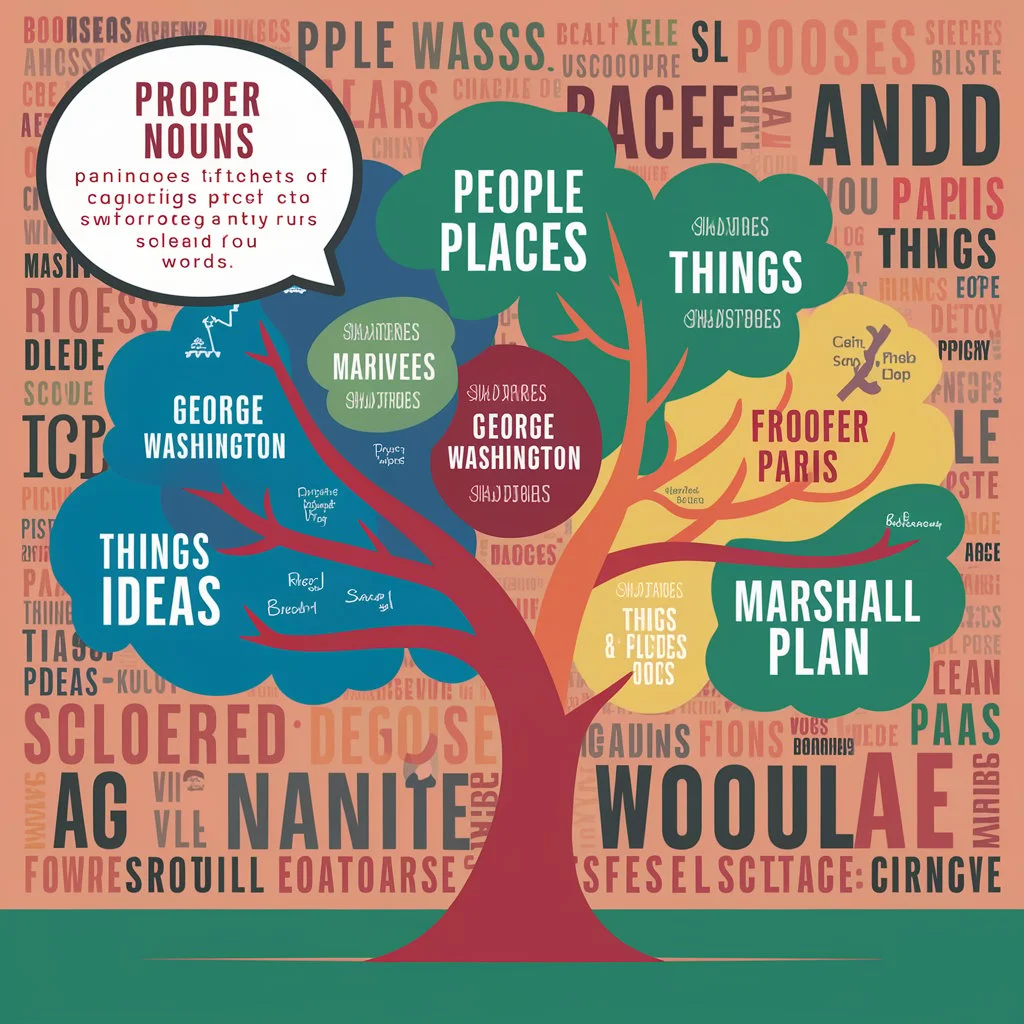Proper noun, an essential part of our language, allowing us to identify and distinguish specific people, places, things, or ideas.A quite easy and simplle definition is given along with examples to get deep understanding. These special nouns stand out because they always begin with a capital letter, signifying their uniqueness and importance. Understanding proper nouns is crucial for effective communication, as they help us refer to specific entities with clarity and precision. In this guide, we will explore the definition, examples, and various roles of proper nouns in sentences.
Proper Noun Definition
A proper noun is a special type of noun used to denote specific people, places, things, or ideas. It’s like a nametag that distinguishes individual entities. They stand out in a crowd, signifying individuality. For instance, think of your name—unique, special, and distinctively you. That’s a proper noun!
Proper Noun Examples
Proper nouns come in various forms:
| Type of Proper Noun | Proper Noun Example |
| Person Names | Emma Watson |
| Place Names | Paris, France |
| Company Names | Microsoft Corporation |
| Title Names | President Biden |
Why Do Proper Nouns Get Capitalized?
Proper nouns always begin with a capital letter, regardless of their position within a sentence. The capitalization of proper nouns holds significant importance in language, as it serves to emphasize and distinguish specific entities.
Importance of Capitalizing Proper Nouns
Distinct Identification:
Capitalizing the initial letter of a proper noun differentiates it from common nouns. It highlights the importance and individuality of the named entity, whether it’s a person, place, thing, or idea.
Clarity in Communication:
Capitalisation aids in clarity by signalling the start of a proper noun. It assists readers or listeners in identifying and recognising names or specific terms instantly within a sentence.
Enhanced Readability:
Proper capitalization contributes to the readability of written text. It helps structure sentences and paragraphs effectively, guiding readers to focus on the specific entities mentioned.
Respect and Formality:
Capitalizing proper nouns shows respect or importance to the named entity. For instance, using capitalization in names of institutions, historical events, or titles reflects formality and reverence.
Grammar and Style Rules:
Following the grammatical convention of capitalizing proper nouns is a fundamental aspect of language structure and style. Adhering to these rules enhances overall writing proficiency.
Functions of Proper Nouns in Sentences
The functions of proper nouns in sentences showcase how these unique names play various roles in conveying specific information. Understanding these functions allows us to grasp the versatility of proper nouns in sentences. They play pivotal roles in communicating specific information, whether as the subject, object, possessive form, or in addressing individuals or places.
Subject of a Sentence:
- Role: Proper nouns can function as the subject of a sentence, performing the action or being the focus of the sentence.
- Example: “John runs every morning.” Here, “John” is the subject performing the action “runs.”
Object of a Verb:
- Role: Proper nouns often serve as the object upon which the action of a verb is performed.
- Example: “Sheila visited Paris.” In this sentence, “Paris” is the object receiving the action “visited.”
Direct Object in a Sentence:
- Role: Proper nouns can function as the direct object that directly receives the action of the verb.
- Example: “The cat chased Tom.” Here, “Tom” is the direct object being chased by the cat.
Addressing People or Places:
- Role: Proper nouns are commonly used when addressing or mentioning specific individuals, locations, or titles.
- Example: “Hello, Mr. Smith!” or “Let’s visit New York.”
Showing Ownership or Possession:
- Role: Proper nouns often indicate ownership or possession, especially when used in possessive forms.
- Example: “This is Jennifer’s book.” The possessive form of “Jennifer” shows that the book belongs to her.
Proper Nouns as Modifiers:
- Role: Proper nouns can act as modifiers, enhancing or specifying other nouns in a sentence.
- Example: “She drives a Toyota car.” Here, “Toyota” modifies and specifies the type of car she drives.
Proper Nouns vs. Common Nouns
While common nouns refer to general entities, proper nouns pinpoint specific ones. For instance, “bird” is a common noun, whereas “Blue Jay” is a proper noun—highlighting a specific type of bird.
Key Differences:
- Specificity vs. Generalization: Proper nouns point to particular individuals or entities, while common nouns refer to a group or category.
- Capitalization: Proper nouns always begin with a capital letter, whereas common nouns only capitalize at the start of a sentence or within titles.
- Individuality: Each proper noun denotes a unique entity, while common nouns represent a class or type of entity.
Examples of Proper Nouns vs. Common Nouns:
- Proper Noun Example: “I visited the Empire State Building.” Here, “Empire State Building” is a specific place name, a proper noun.
- Common Noun Example: “We visited a building in New York City.” “Building” is a general term (a common noun) referring to any structure, not a specific one.
Proper Nouns with Definite Articles: Exploring Unique Situations
When it comes to proper nouns, the typical rule is that they stand alone without any articles like “the,” “a,” or “an.” However, there are exceptions where proper nouns incorporate definite articles, adding a unique twist to their usage in language.
Instances of Proper Nouns with Definite Articles:
Country Names:
- Some countries have names that include common nouns like “republic” or “kingdom.” In these cases, the entire name, including the common noun part, might use the definite article “the.”
- Example: “The United States of America” and “The People’s Republic of China.”
Organizational Titles:
- Certain organizations or institutions incorporate “the” as part of their official title.
- Example: “The Modern Language Association” or “The National Aeronautics and Space Administration (NASA).”
Unique Proper Nouns:
- Some specific entities or names are conventionally used with definite articles due to their historical or cultural context.
- Example: “The Hague,” “The Bronx,” or “The White House.”
Understanding the Exceptions:
While most proper nouns stand alone without articles, these exceptions involving definite articles showcase distinct cases where common nouns are part of the proper noun itself. These exceptions often stem from historical, cultural, or structural reasons, deviating from the general rule.
Recognizing these unique scenarios helps in appropriately using definite articles with specific proper nouns, ensuring clear and accurate communication in various contexts.
Pluralize Proper Nouns
Pluralize proper nouns are special words that talk about things that are already in groups. They’re different from regular proper nouns because they’re always plural. In this part, we’ll look at these special words and see how they’re used.
Examples of Pluralized Proper Nouns:
Geographical Entities:
- Certain geographical locations, often comprised of multiple components, inherently exist in plural form.
- Example: “The Himalayas,” “The Netherlands,” or “The Philippines.”
- Usage: “Explorers dream of conquering the Himalayas.”
Historical Events or Periods:
- Specific historical events or periods that have been consistently referred to in their plural form.
- Example: “The Middle Ages,” “The Roaring Twenties,” or “The Renaissance.”
- Usage: “Literature enthusiasts study the art of writing from the Middle Ages.”
Collective Noun Phrases:
- Some phrases refer to groups or entities that are naturally in a collective, pluralized form.
- Example: “The United Arab Emirates,” “The United Nations,” or “The Rolling Stones.”
- Usage: “Diplomats gather at the United Nations headquarters.”
Exercise: Spot the Proper Nouns!
Instructions: Read the following sentences and identify the proper nouns.
- Sheila enjoys playing the piano in her spare time.
- The Taj Mahal in India is a breathtaking sight.
- Have you read Harry Potter and the Sorcerer’s Stone by J.K. Rowling?
- Last summer, we visited Yellowstone National Park.
- Mount Kilimanjaro is the highest peak in Africa.
- Alice wants to visit London and see Big Ben.
- Microsoft Corporation recently launched new software.
- The Great Wall of China stretches over thousands of miles.
- Einstein was a brilliant scientist.
- The Amazon River is the second-longest river in the world.
Answers:
- Sheila
- The Taj Mahal, India
- Harry Potter and the Sorcerer’s Stone, J.K. Rowling
- Yellowstone National Park
- Mount Kilimanjaro, Africa
- Alice, London, Big Ben
- Microsoft Corporation
- The Great Wall of China
- Einstein
- The Amazon River
FAQs
Is Oreo a proper noun?
Yes, Oreo is a proper noun because it refers to a specific brand of cookies.
Is Christmas a proper noun?
Yes, Christmas is a proper noun as it denotes a specific holiday celebrated worldwide.
Is “French fries” a proper noun?
No, French fries is not a proper noun. It is a common noun referring to a type of food.
Is Cheerios a common or proper noun?
Cheerios is a proper noun because it refers to a specific brand of breakfast cereal.
What are 4 types of proper nouns?
- Person Names: e.g., Albert Einstein
- Place Names: e.g., Paris
- Company Names: e.g., Microsoft
- Title Names: e.g., Doctor Smith
Final words
In conclusion, understanding proper nouns is essential for precise and effective communication. These unique nouns, which always start with a capital letter, help us identify specific people, places, things, and ideas. Recognizing and correctly using proper nouns enhances our language skills and ensures clarity in both written and spoken forms. By mastering the use of proper nouns, we can appreciate the individuality and significance of the entities they represent.

It’s Elara Winters, your guide at “Grammer Grove.” I’ve dived into the intricacies of crafting the perfect English writing sections for your project, research paper, or thesis. With a wealth of experience in this field, I’m here to help you express gratitude and appreciation effectively. Join me on this journey, and let’s make your English writings shine!












